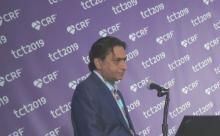SAN FRANCISCO – The was 10% at 30 days and increased to 24% at 1 year, results from a PARTNER 3 substudy demonstrated.
However, the lack of a clear association with serious clinical events such as death, MI, and stroke “does not justify the routine prophylactic use of anticoagulation [following TAVR] in all patients,” lead study investigator Raj R. Makkar, MD, said during a press briefing at the Transcatheter Cardiovascular Therapeutics annual meeting.
“Subclinical leaflet thrombosis characterized by hypoattenuated leaflet thickening and reduced leaflet motion has been frequently observed in transcatheter and surgical aortic bioprosthetic valves,” said Dr. Makkar, director of the interventional cardiology division, Cedars-Sinai Medical Center, Los Angeles. “Thrombus on bioprosthetic valves can present as a spectrum: HALT with relatively normal leaflet motion, HALT with reduced leaflet motion but normal gradients, and clinical valve thrombosis with elevated gradients.”
The primary objective of the current Food and Drug Administration–mandated study, known as the PARTNER 3 Low-Risk Computed Tomography Sub-study, was to evaluate HALT and reduced leaflet motion in terms of differences in transcatheter and surgical bioprosthetic aortic valves among patients enrolled in the randomized PARTNER 3 cohort, to understand the natural history of HALT and reduced leaflet motion in the absence of anticoagulation, and to understand its impact on valve hemodynamics and clinical outcomes. Patients underwent specialized serial CTs at 30 days and at 1 year post TAVR or surgical aortic valve replacement (SAVR). All scans were analyzed by a CT core lab blinded to patient information or time of the scans, and the treating investigators were blinded to the results of the 30-day and 1-year CT scans. A clinical events committee adjudicated key clinical events.
Dr. Makkar reported outcomes from 408 patients: 213 who underwent TAVR and 195 who underwent surgery. There were 348 evaluable serial CT scans at 30 days and 312 at 1 year. The incidence of HALT at 30 days was 13.3% in the TAVR group and 5% in the surgery group, a difference that reached statistical significance (P = .03). At 1 year, however, the difference was not significant (27.5% vs. 20.2%, respectively; P = .19). In the overall cohort, he said, the incidence of HALT was 10% at 30 days and increased to 24% at 1 year.
The researchers also found that HALT was dynamic and spontaneously resolved in 56% of patients in the absence of anticoagulation at 30 days, while new HALT appeared in 21% of patients at 1 year.
“In terms of its impact on valve gradient, the impact was minimal,” Dr. Makkar said. “There was an increase of 1-2 mm Hg in patients who had HALT and in patients who had reduced leaflet motion.”
As for impact on clinical outcomes, the researchers observed no deaths or any myocardial infarction at any time point in patients who had HALT. “There were four cases of valve thrombosis, three of which occurred in patients who had HALT,” Dr. Makkar said at the meeting, sponsored by the Cardiovascular Research Foundation. “One stroke occurred in each group. TIA [transient ischemic attack] occurred in 1 patient out of 35 in the HALT group and 3 out of 311 in the no-HALT group. There was one case of retinal artery embolism in each group.”
In a pooled analysis of clinical events, he and his colleagues observed a numerical increase in death, stroke, TIA, and thrombotic events in patients who had HALT at 30 days, compared with those who did not (8.6% vs. 2.9%, respectively), but the difference did not reach statistical significance (P = .11). “However, given the low total number of events, the data are inconclusive and only hypothesis generating,” he said. “A longer-term follow-up and [a] larger data set will further clarify the impact on clinical outcomes.”
Dr. Makkar emphasized that routine post–TAVR/SAVR CT scans outside of research protocols are not indicated. “CTs should be prompted by increased gradients or thromboembolic events,” he said.
One of the discussants at the briefing, Michael J. Mack, MD, chair of the cardiovascular service line at Baylor Scott and White Health in Dallas and primary author of the PARTNER 3 study, said that prior to the substudy results, “I’ve always thought that the incidence of valve thrombosis would be higher with TAVR than with surgery. So the fact that it was higher at 30 days didn’t surprise me. One of the reasons is that you lose the backwashing effect by changing flow dynamics in the aortic route. What did surprise me is the percent that resolved without anticoagulation.”
He added, “The impact of all this is that we are not justified recommending routine anticoagulation [after bioprosthetic aortic valve replacement surgery]. I think it does call into question the guidelines for surgical valves, because we did that based on smaller observational studies. Now that we have routine surveillance of surgical valves, I think it calls into question the class IIa recommendation for 3 months of anticoagulation. It’s what we’ve always done, and we’ll probably stop doing it on the basis of this. The other shoe that hasn’t dropped is its effect on long-term structural valve deterioration. I do think that early HALT does explain premature structural valve deterioration.”
The trial was sponsored by Edwards Lifesciences. Dr. Makkar disclosed that he is a consultant for and has received research grants from Edwards Lifesciences, Abbott, Medtronic, and Boston Scientific. Dr. Mack is a consultant to Gore and an investigator for Abbott, Edwards Lifesciences, and Medtronic.


